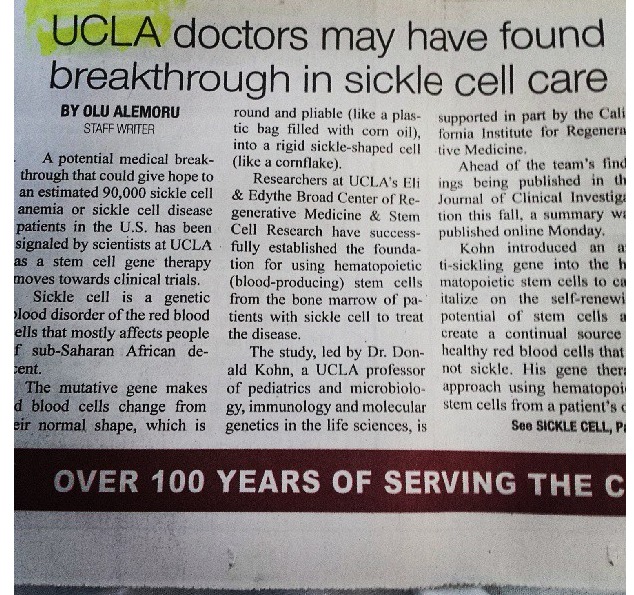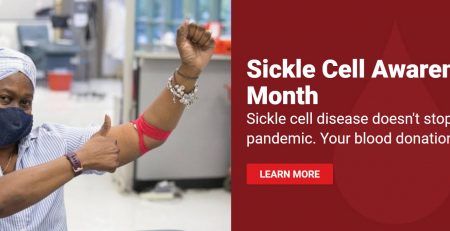UCLA doctors may have found breakthrough in Sickle Cell Care
Journalist Shaun Mason out of the UCLA Newsroom reports the following;
Researchers at UCLA’s Eli and Edythe Broad Center of Regenerative Medicine and Stem Cell Research have successfully established the foundation for using hematopoietic (blood-producing) stem cells from the bone marrow of patients with sickle cell disease to treat the disease. The study was led by Dr. Donald Kohn, professor of pediatrics and of microbiology, immunology and molecular genetics
Sickle cell disease causes the body to produce red blood cells that are formed like the crescent-shaped blade of a sickle, which hinders blood flow in the blood vessels and deprives the body’s organs of oxygen.
Kohn introduced an anti-sickling gene into the hematopoietic stem cells to capitalize on the self-renewing potential of stem cells and create a continual source of healthy red blood cells that do not sickle. The breakthrough gene therapy technique for sickle cell disease is scheduled to begin clinical trials by early 2014. The study was published online today ahead of press in the Journal of Clinical Investigation.
Kohn’s gene therapy approach, which uses hematopoietic stem cells from a patient’s own blood, is a revolutionary alternative to current sickle cell disease treatments as it creates a self-renewing normal blood cell by inserting a gene that has anti-sickling properties into hematopoietic stem cells. This approach also does not rely on the identification of a matched donor, thus avoiding the risk of rejection of donor cells. The anti-sickling hematopoietic stem cells are transplanted back into the patient’s bone marrow and multiply the corrected cells that make red blood cells without sickling.
“The results demonstrate that our technique of lentiviral transduction is capable of efficient transfer and consistent expression of an effective anti-sickling beta-globin gene in human sickle cell disease bone marrow progenitor cells, which improved the physiologic parameters of the resulting red blood cells,” Kohn said.
Kohn and colleagues found that in the laboratory the hematopoietic stem cells produced new non-sickled blood cells at a rate sufficient for significant clinical improvement for patients. The new blood cells survive longer than sickled cells, which could also improve treatment outcomes.
Sickle cell disease mostly affects people of Sub-Saharan African descent, and more than 90,000 patients in the U.S. have been diagnosed. It is caused by an inherited mutation in the beta-globin gene that makes red blood cells change from their normal shape, which is round and pliable, into a rigid, sickle-shaped cell. Normal red blood cells are able to pass easily through the tiniest blood vessels, called capillaries, carrying oxygen to organs such as the lungs, liver and kidneys. But due to their rigid structure, sickled blood cells get stuck in the capillaries.
Current treatments include transplanting patients with donor hematopoietic stem cells, which is a potential cure for sickle cell disease, but due to the serious risks of rejection, only a small number of patients have undergone this procedure and it is usually restricted to children with severe symptoms.
This study was supported in part by a Disease Team I Award from the California Institute for Regenerative Medicine, the state’s stem cell research agency, which was created by a voter initiative in 2004. The purpose of the disease team program is to support research focused on one particular disease that leads to the filing of an investigational new drug application with the FDA within four years. The program is designed to speed translational research — research that takes scientific discoveries from the laboratory to the patient bedside. This requires new levels of collaboration between basic laboratory scientists, medical clinicians, biotechnology experts and pharmacology experts, to name a few.
Other support came from UCLA’s Broad Stem Cell Research Center and Jonsson Comprehensive Cancer Center, and from the Ruth L. Kirschstein National Research Service Award.
The Eli and Edythe Broad Center of Regenerative Medicine and Stem Cell Research: UCLA’s stem cell center was launched in 2005 with a UCLA commitment of $20 million over five years. A $20 million gift from the Eli and Edythe Broad Foundation in 2007 resulted in the renaming of the center. With more than 200 members, the Broad Stem Cell Research Center is committed to a multi-disciplinary, integrated collaboration of scientific, academic and medical disciplines for the purpose of understanding adult and human embryonic stem cells. The center supports innovation, excellence and the highest ethical standards focused on stem cell research with the intent of facilitating basic scientific inquiry directed towards future clinical applications to treat disease. The center is a collaboration of the David Geffen School of Medicine, UCLA’s Jonsson Cancer Center, the Henry Samueli School of Engineering and Applied Science and the UCLA College of Letters and Science.



